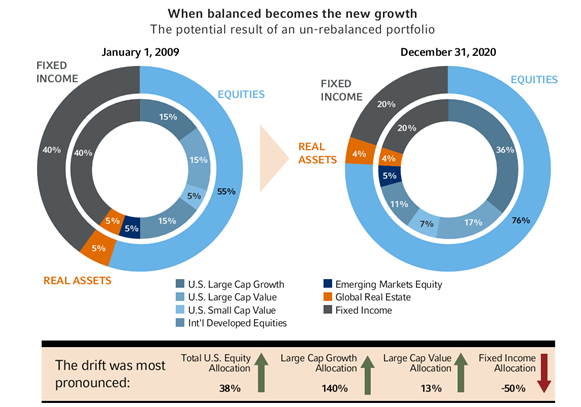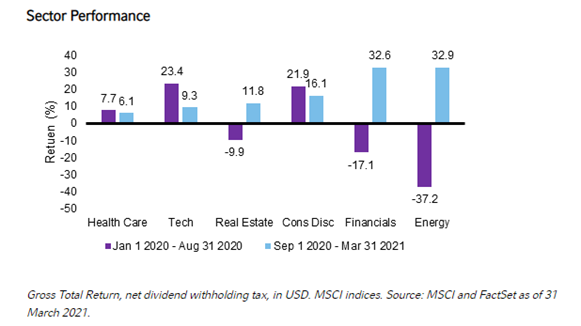A is for active rebalancing. Don’t underestimate that value.
If there were ever a year in which the benefits of rebalancing were clear, 2020 was it.
We’re still immersed in the middle of a market, economic and societal event like none of us have ever experienced. We’ve all been impacted - if not directly to our health, then by changes to the way we work, the way we connect to each other and certainly by the way we think about financial security.
At Russell Investments, we believe in the value of an adviser. And this year, we believe advisers are more valuable than ever. The global pandemic upended all of our lives - and for many of us, caused us to reassess our values, outlook and lifestyles. The market volatility may also have had investors reconsider their risk tolerance or their portfolio mix. These are the circumstances in which advisors are called to play many roles: behaviour coach, family wealth adviser, investment manager, product specialist, and more.
My colleagues and I will be discussing those various roles and the potential benefits each brings to clients, in four deeper dive articles, looking in greater detail at our annual study on this topic. This is our first of those four, in which we look closely at active rebalancing.
When markets are rising calmly, it can be easy to underestimate the importance of disciplined rebalancing. But when markets gyrate wildly - as they did in March last year as the pandemic shuttered many aspects of the global economy - then the value of active rebalancing can’t be understated.
Minimise the drift
As the chart below demonstrates, a hypothetical balanced index portfolio that has not been rebalanced since the last major bout of market volatility during the Global Financial Crisis would have ended 2020 looking more like a growth portfolio, and would have exposed the investor to unintended risk. Indeed, without rebalancing, by the end of December 2020, this hypothetical portfolio’s exposure to U.S. large cap growth would have risen from 15% to 36% and the exposure to fixed income would have fallen from 40% to 20% - an unintended shift from a 60% equity / 40% fixed income portfolio to an 80% equity / 20% fixed income portfolio.
We all know the important role fixed income plays in smoothing out portfolio returns. More importantly, the portfolio would have a strong tilt to U.S. large cap growth - increasingly dominated by technology names. That tilt could be a concern if that sector were to suddenly reverse.
Click image to enlarge

Source: Hypothetical analysis provided in the chart and table above is for illustrative purposes only. Not intended to represent any actual investment. Source for both chart and table: U.S. Large Cap Growth: Russell 1000 Growth Index, U.S. Large Cap Value: Russell 1000 Value Index, U.S. Small Cap: Russell 2000® Index, International Developed Equities: MSCI World ex USA Index, Emerging Markets Equity: MSCI Emerging Markets Index; Global Real Estate: FTSE EPRA NAREIT Developed Index, and Fixed Income: Bloomberg U.S. Aggregate Bond Index.
Markets turn fast. Is now the right time to rebalance?
2020 was a textbook example of how quickly markets can turn. The chart below shows just how dramatic the shift in sector performance was over the past year. For the first half of 2020, healthcare and technology stocks led the market. Within technology, those companies that benefited from the move to a virtual environment in 2020 - think Amazon, Alphabet (Google), Facebook, Microsoft and Apple - rose to represent 26% of the market cap of the S&P 500® Index in 2020. That’s a level of market concentration we haven’t seen in data we have going back 40 years. As of September 2020, traditional value-oriented sectors such as financials and energy have outperformed.
Click image to enlarge
All of this speaks to the importance of regular rebalancing. Without it, it’s likely that the increasing dominance of certain technology names in the S&P 500® Index could have pushed your clients’ asset allocations away from their policy targets to something with a greater tilt toward growth.
How are you talking to your clients about the importance of regular rebalancing?
The value communication gap
Do your clients recognise the value of what you do? Articulating the value of all the good things that advisers do - including rebalancing - is dependent on good communication, especially now that most of our interactions are virtual. This communication should include what you write - via client emails, your online presence, or via traditional mail - but should also include what you say when you’re on the phone, in a webinar or on video chat with clients.
We believe that rebalancing is one of the five most vital functions advisers provide. But the value of it is often downplayed. And when it comes to devaluing this vital service, advisers may be the main culprit. Why? Because it’s something they do every single day. It’s like breathing for advisers, and most of their clients don’t think about the impact of doing it or not doing it.
Unless you clearly communicate the value of rebalancing, don’t expect your clients to appreciate it. We believe that without the help of advisers, clients are more likely to make serious mistakes, such as buying high, selling low, or running to cash at precisely the wrong time. Indeed, many investors did flee the markets in March 2020, when the initial pandemic shock hit, and may have then missed out on the subsequent rebound.
How to tell the rebalancing story
Do your clients recognise the value of annual rebalancing and how it’s a vital part of wealth management? We recommend four simple touchpoints to make the communication both easy for you and meaningful for your investor clients.
To help your clients understand the value of active rebalancing, make sure you let them know:
- The benefits of a systematic rebalancing policy
- What the strategic rebalancing policy is
- How frequently the portfolios are rebalanced
- Your approach to strategic rebalancing during periods of market volatility
The bottom line
Rebalancing may have been more obviously valuable over the past year than ever before. But just because you recognise its importance, don’t assume your clients do. For them to understand the value of an active rebalancing process, you need to talk about it. This doesn’t have to be a complicated conversation - in fact, just showing them the charts above should help them see how the process can keep their plans on track. But we believe you should articulate your active rebalancing philosophy, because rebalancing is a key part of helping your investors achieve the financial security that matters so much to them.
Any opinion expressed is that of Russell Investments, is not a statement of fact, is subject to change and does not constitute investment advice.
